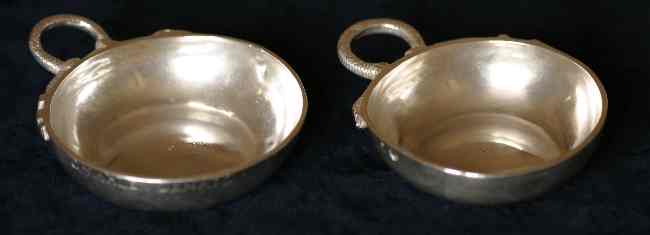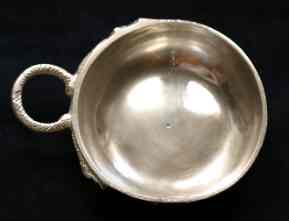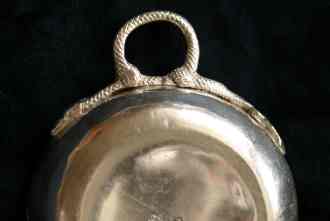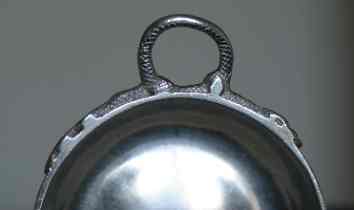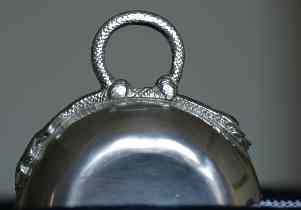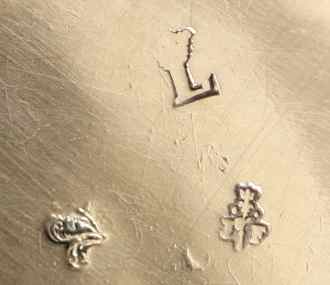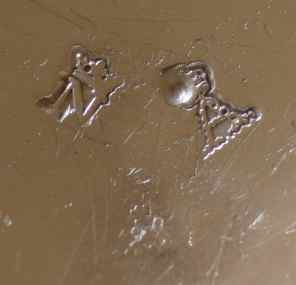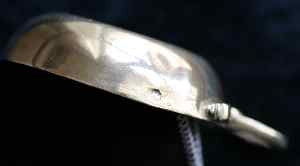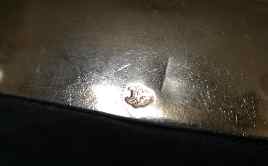by Michael
Carter
(click on photos to enlarge image)
A PAIR OF 18TH CENTURY FRENCH WINE TASTERS
In this article, I present two silver wine tasters by
Jacques Famechon, who was admitted as a master silversmith in
Paris on March 15, 1770 and was still active in 1787.
A wine taster, as its name implies, is for tasting wine and for
observing its color, and several types existed in the 18th
century in France, each one corresponding to a particular
wine-making region. The types vary according to the form of the
handle and the presence or absence of decorative motifs. One can
find wine tasters with a handle in the form of a snake, with a
rolled handle, with a thumb-rest, with a shell- or lily-shaped
handle or with no handle at all. A variant of the wine-taster is
the so called hunting cup, which is very rare and much sought
after. These types also varied according to their size, the
smallest being used for spirits, medium-sized ones for wine and
the largest for cider.
The type with the snake-shaped handle, which is presented in
this article, is among the most common. It originated in
Burgundy, but examples can be found elsewhere, such as in
Auvergne, Berry and even in Paris. The handle is in the form of
a snake, an amphisbaena (a kind of snake supposed to have a head
at either end of its body) or even two snakes that meet in the
middle, either mouth to mouth or separated by a grape seed. The
snakes’ body can be smooth or covered with scales.
Even before examining the punch marks on the two wine
tasters presented here, which allow us to date these objects and
identify the maker, we can see that they have various things in
common that allow us to suppose that they are the work of the
same silversmith. In both cases, the handle is in the form of a
snake, which is added and soldered to the cup. The snake’s body
is covered with scales and forms a horizontal loop, which can be
grabbed between thumb and forefinger. The undulation of the tail
suggests movement. When viewed from above, one of the wine
tasters has the snake’s head on the right, the other on the
left. One also notices that the cup, which sits directly on its
base, is very thick and rather heavy. Unlike the snake’s body,
it is smooth and without decoration.
In France, silver wine tasters, which were still quite rare
before the death of Louis XIV in 1715, had their golden age in
the middle of the 18th century. Unlike silver plates, flatware,
candlesticks and other items that decorated the tables of the
aristocracy, the wine taster is "a popular object sometimes called
… Personal and Popular Wine Cup, which accounts for the frequent
presence of a name engraved on the body."(see
endnote)
Engraved on one of the wine tasters presented here is the name
"CHARLE DEHAIS," who was no doubt one of the previous owners if
not the original owner.
The charge, warranty and maker’s marks on these two wine
tasters are found on the base, while the discharge mark, which
attests the payment of the tax, is on the edge of the cup near
the snake’s head. The choice of the location of the discharge
mark had a practical purpose, of course, since it was intended
to discourage grafting, but it probably also had an artistic
purpose, since the snake seems to be watching the punch mark, as if
it were lying in wait for prey, ready to bite anyone who would
dare try to remove it.
The duty and warranty marks on these two wine tasters allow us
to date them within a few months or years.
On the smaller of the two, which is also the older, we can see
the duty marks for large works of silver in use from October 1,
1768 to November 17, 1774 (crowned letter A for the charge and
woman's head for the discharge) and the warranty mark in use
from July 16, 1774 to July 14, 1775 (crowned letter L). We know,
therefore, that this work was completed between July 16 and
November 17, 1774. The maker’s mark is very visible and,
therefore, easy to identify as that of Jacques Famechon.
On the other wine taster, we can see the duty marks for large
works of silver in use from November 18, 1774 to July 12, 1780
(crowned letter A for the charge and bull’s head for the
discharge) and the warranty mark in use from July 13, 1776 to
August 12, 1777 (crowned letter N). We know, therefore, that the
warranty mark was applied between the latter two dates. The work
was probably completed shortly thereafter. The maker’s mark on
this wine taster is only partially visible, but, by examining it
with a loupe and comparing it to the one on the other wine
taster, we can tell that it is indeed the same mark.
BIBLIOGRAPHY
A. de Charette, Précis d’orfèvrerie ancienne (1986).
L. Carré, Guide de l’amateur d’orfèvrerie française (1990).
E. Beuque & M. Frapsauce, Dictionnaire des poinçons de
maîtres-orfèvres français du XIVe siècle à 1838 (1929).
C. Ginter, Les 6000 poinçons de l’orfèvrerie française sous
Louis XVI (1774-1791) (2009).
|
|
 ASSOCIATION OF SMALL COLLECTORS OF ANTIQUE SILVER
ASSOCIATION OF SMALL COLLECTORS OF ANTIQUE SILVER